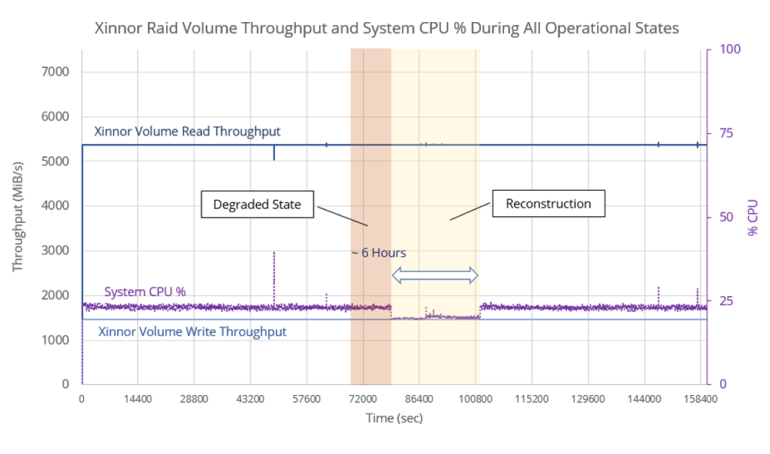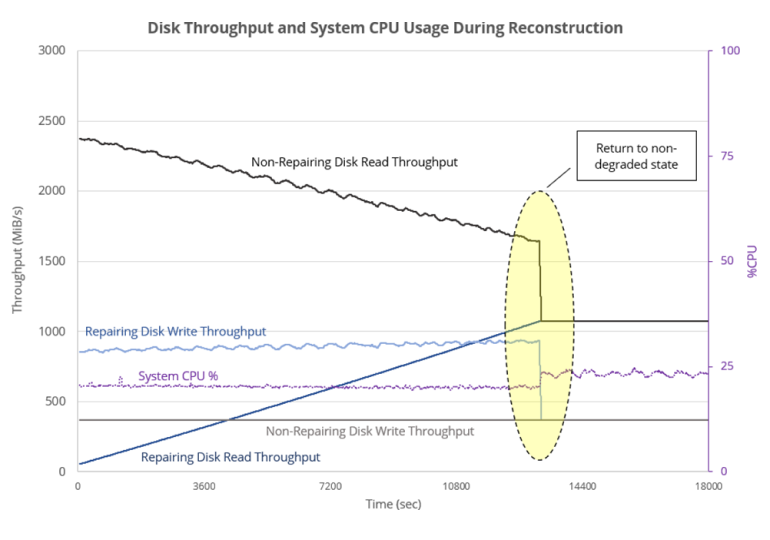We use cookies to personalize your site experience.
Privacy policyTechnology Partners
About
The CSD 3000 series of Computational Storage Drives is a powerful solution that can help you optimize your infrastructure by increasing storage density and compute performance while lowering the costs of data storage. The CSD 3000 combines the features of a high-performance NVMe SSD with Hardware Compute Engines to provide a flexible, easy-to-use Computational Storage Drive solution. This innovative technology can help you achieve higher levels of efficiency and productivity, unlocking new possibilities for your business.
Solution
Evaluating a RAID solution's performance in degraded and reconstructing states is crucial. In the degraded state, fewer drives are available to serve IO requests, and intra-RAID IO adds traffic as data on good disks is used to reconstruct the data on the new disks. One of xiRAID's key features is the ability to control the rate of array reconstruction, enabling predictable and efficient reconstruction. ScaleFlux CSD 3310 NVMe SSDs feature transparent inline compression that reduces the impact of intra-RAID reconstruction IO. Combining these technologies creates a best-in-class software RAID solution that can handle high-performance workloads under all RAID operating states.
Test Results
Test environment: a dual-socket Xeon Gold 6342 CPU with 48 physical cores and 512GB of DRAM, paired with five 7.68TB ScaleFlux CSD 3310 PCIe Gen 4 SSDs and Xinnor’s xiRAID in RAID 5. The operating system was Ubuntu 22 with kernel version 5.15.0-70, and performance was evaluated using with the Aerospike certification tool.

While the array is reconstructing, CPU utilization experiences a slight decrease, but the total read and write throughput remain constant at 5.4GB/s and 1.7GB/s, respectively.
A more detailed analysis of the reconstruction phase involves measuring the read and write throughput of a normal drive and the drive undergoing reconstruction:

The non-repairing disk maintains a constant write throughput but handles a higher read throughput by contributing to the data on the reconstructing disk. The volume of data read from the non-repairing disk decreases as the reconstruction progresses, and at the end of the phase, both disks contribute equally to the workload.
Download the application note to learn more about test setup and results: https://xinnor.io/files/
Conclusion
To maintain consistent performance and low latency, it's crucial to minimize the impact of reconstruction traffic on host IO performance. XiRAID's tunable reconstruction priority and CSD 3310’s transparent compression help achieve this goal. By deploying a high-performance and resilient RAID array, the probability of node failure can be reduced, avoiding costly node-level rebuilds. This increased reliability may also allow for a reduction in node-level redundancy, such as deploying double replication instead of triple replication. This implementation can reduce server count, rack space, network utilization, and required node-level licenses.
About
ScaleFlux
ScaleFlux is a company that specializes in developing innovative storage solutions for data centers and cloud computing. Their flagship product is the CSD (Computational Storage Drive) series, which combines the features of a high-performance NVMe SSD with Hardware Compute Engines to provide a flexible, easy-to-use Computational Storage Drive solution. The CSD series helps to multiply the efficiency of infrastructure, increasing storage density and compute performance while lowering the costs of data storage. With a focus on delivering high-performance, cost-effective, and scalable storage solutions, ScaleFlux is a leading player in the storage industry.
